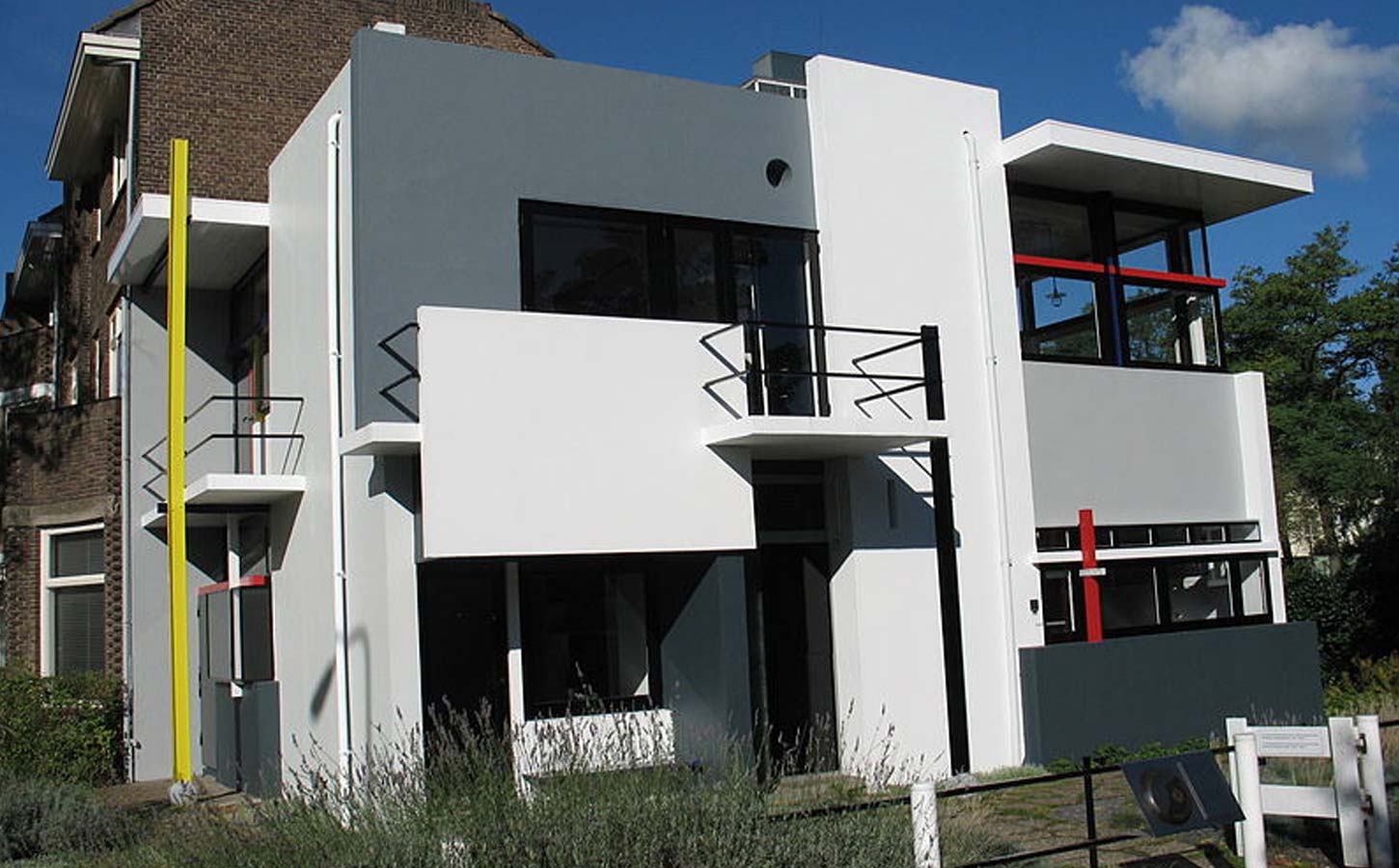The Emeryville Tattler Emeryville's Architectural Disneyland De Stijl
The Rietveld Schröder House in Utrecht, 1924 - the only building realised completely according to the principles of "De Stijl" De Stijl ( / də ˈstaɪl /; Dutch pronunciation: [də ˈstɛil], Dutch for "The Style"), also known as Neoplasticism, was a Dutch art movement founded in 1917 in Leiden. De Stijl consisted of artists and architects. [1]

100 jaar de Stijl. Het stadhuis omgetoverd in Mondriaan stijl
Gothic Art Baroque (1600-1750) De Stijl is one of the most iconic and influential artistic movements of the 20th century. Its members' strict rules and lofty ambitions resulted in a style that still resonates today. To some, De Stijl paintings might just look like a collage of rectangles.

The Look of Modern Architecture De stijl, Utrecht and Architecture
Key Ideas & Accomplishments Like other avant-garde movements of the time, De Stijl, which means simply "the style" in Dutch, emerged largely in response to the horrors of World War I and the wish to remake society in its aftermath.

1Mondrian1.jpg 1,200×675 pixels Mondrian, Architecture design
July 15, 2022 Historic art movements and their visual characteristics have considerably paved the way for modern day architecture. For years, architects have been borrowing techniques and stylistic.

De Stijlinspired home in Kiev features massive pergola wall for privacy
Still the De Stijl architects managed to build a few private homes and two notable attempts at small public buildings. The absolutism inherent in De Stijl could be linked to the practical in architecture, that is, mass-produced elements allowed architecture to achieve a uniform, stripped-down reduced look.

de stijl movement Google Search en 2023 De stijl architecture, De
The following are some of the most famous buildings constructed in the De Stijl Style:Gerrit Rietveld's Schroder House,Hendrik Wijdeveld's Spacerexperimental house,Jacobus Oud's Sonnenbisschen Building,Vincent van Duysen's Sint-Maria-Oudenhove,and the Schindler House.All these buildings make use of the simplest forms and primary colours.

Képtalálat a következőre „mondrian architecture” Mondrian Architecture
De Stijl architecture is a movement that began in the Netherlands in 1917 and was heavily influenced by Dutch painter and theoretician Theo van Doesburg. The movement, which is often referred to simply as 'De Stijl', focused on the use of simple geometric forms, primary colors, and asymmetrical compositions.

De Stijl spot Dutch design on Dutch streets Your Dutch Guide
Examples of De Stijl buildings around the world. One notable example of a De Stijl building can be found in the heart of Amsterdam, the iconic Schroder House. Designed by Dutch architect Gerrit Rietveld in 1924, this building is considered one of the most significant architectural works of the De Stijl movement. It showcases the movement's.

austin cubed de Stijl architecture De stijl architecture, Cubes
3. The "Breakfast With Mondrian" Apartment This experimental apartment highlights the forms, lines, and colors of Piet Mondrian's art. "Breakfast with Mondrian" is a concept by design duo Brani & Desi inspired by the artist's work and vision.

this fictional architectural visualization depicts the amalgamation of
De Stijl, 1917-1928 Date 1952 Publisher [publisher not identified] Exhibition URL www.moma.org/calendar/exhibitions/1798 The Museum of Modern Art's exhibition history—from our founding in 1929 to the present—is available online. It includes exhibition catalogues, primary documents, installation views, and an index of participating artists. MoMA

43 best images about De Stijl on Pinterest House interiors
Which interior building is an example of De Stijl . Rietveld's Schröder House is considered to be the best example of a total De Stijl environment. The house was designed by Rietveld in 1924 and is located in the Netherlands. The house is characterized by its use of simple geometric shapes, primary colors, and lack of ornamentation.

Xavier Delory imagines Gerrit Rietveld's Schröder house covered in De
De Stijl, Part I: Total Purity. by Dr. Charles Cramer and Dr. Kim Grant. Piet Mondrian, Composition with Blue, Red, Yellow, and Black, 1922, oil on canvas, 41.9 x 48.9 cm (Minneapolis Institute of Art) De Stijl is one of the most recognizable styles in all of modern art. Consisting only of horizontal and vertical lines and the colors red.

The Rietveld Schroder House An Iconic 20th Century House of the De
Piet Mondrian, Composition with Blue, Red, Yellow, and Black, 1922, oil on canvas, 41.9 x 48.9 cm (Minneapolis Institute of Art) De Stijl is one of the most recognizable styles in all of modern art. Consisting only of horizontal and vertical lines and the colors red, yellow, blue, black, and white, De Stijl was applied not only to easel.

Rietveld Schröder House and De Stijl movement Architectural Visits
De Stijl as a collection of diverse projects coalesced under van Doesburg in a desire to achieve international unity through "the sign of art. The clearest way to distill De Stijl is to examine its ideas made evident in painting, sculpture, graphic design, and, most significantly, architecture.

Pin on DesignInteriors (IDI)
Dutch for "the style," De Stijl is an art movement founded in the city of Leiden in the Netherlands. From 1917 to 1931, De Stijl, also known as neoplasticism, was a famous modern art form that valued abstraction and simplicity. Clean lines, right angles, and primary colors characterized this aesthetic and art movement expressed via.

Theo van DOESBURG (18831931) y Cornelis van EESTEREN (18971988
De Stijl, (Dutch: "The Style") group of Dutch artists in Amsterdam in 1917, including the painters Piet Mondrian, Theo van Doesburg, and Vilmos Huszár, the architect Jacobus Johannes Pieter Oud, and the poet A. Kok; other early associates of De Stijl were Bart van der Leck, Georges Vantongerloo, Jan Wils, and Robert van't Hoff.Its members, working in an abstract style, were seeking laws.